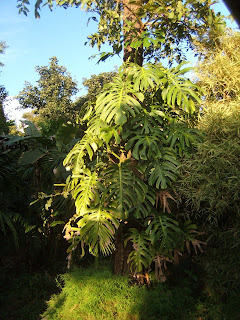The bike ride was lovely--rice paddies, either dry and full of buffaloes grazing contentedly or flooded and now home to pink lotuses, and bungalows set back from the road with coconut orchards in front. There were also a lot of things that reminded me forcibly of Latin America, which is perhaps not strange given the Portuguese influence: whitewashed churches "Our Lady of the Rosary," "Saint Sebastian" and "Holy Trinity;" very frequent Coca-Cola signs, and women wearing not saris but skirts and a jacket or blouse. The little roadside shrines held crosses, not Ganupatti or Saraswati or another god/goddess, faceless with age but no less revered. It made me think of the versatility of human faith, and the need that people have (some people descended from some cultures more than others) to put faith in something, anything. Life of Pi, in which the protagonist, an Indian boy from Pondicherry, is determined to be Hindu, Christian and Muslim, made more sense.
That night, while eating dinner at the hotel, I watched a scene that I have often witnessed in Latin America: a long procession of women, girls, and boys too small to resist, dressed nicely, heading for church. After they had passed, a raucous chorus of "Jingle Bells" burst out of the night. Thinking I was about to see what the men get up to while the ladies are at church (getting drunk) I peered around the corner. Lo and behold, not a staggering drunk tourist or Goan, but a leaping Santa Claus sprang up the steps. He was followed by a procession of children carrying candles and wearing Santa Claus hats. I had to laugh at Santa Claus, dressed for the North Pole, running about in the eighty-degree Goan night--that kid must have been roasting! It's funny what traditions look like when they're transplanted--where did Santa Claus originate? Scandinavia? Germany?
However, on day three of our Goan adventure, I remembered why I choose to travel the way I do. I like to have a project to work on or someone to visit--some means of belonging and contributing to a place. Otherwise I kind of go stir crazy, with all the people trying to sell me stuff and not speaking the language (Kannada is no good in Goa, they speak Marathi and Konkani.) I suppose if my job was to be a nomad, be on the road and travel to a new place every couple days, it might not be that way. But in any event, Nathan and I both got a good case of the Tourist Blues. Even Mr. Resplendent Rat-tail (a tourist from the Netherlands who sported the most intese rat-tail I have ever seen, like unto artistic renderings of Sumo wrestlers, and who one morning burst into a rousing chorus of "What would you do with a drunken Belgian?") ceased to be very amusing.
I spend a lot of time wondering if tourism is good for places. Of course, it's a pretty ideal income source, because if done well, it doesn't directly require exploitation of the place's natural resources. And there are lots of good points--tourists, especially people from very different places, can bring in new good ideas, much-needed money, environmental appreciation of a different kind, and intercultural friendships. But some kinds of tourists bring in cultural and environmental diseases--rudeness, waste, toilet paper, insistence on soft, spoiled lifestyles, a desire to just float along and experience the place without its people, and desires for drugs and sex. In Benaulim I saw evidence of both. In my second quarter of college I read a book on this subject, A Small Place by Jamaica Kincaid. The rhythm of her story pulsed through my mind as I walked in Goa, I just couldn't remember the words. I'll have to read it again. Because as a traveler, this is another very important question.
Here are some pictures. Nathan took almost all of them.
Please pass the salt and Piper nigra...yes that's right, that's a pepper vine!
A nice Goan pig. I didn't see any pigs in Sirsi--Muslims consider the pig unclean and do not eat it, and most Hindus eat either vegetarian or eggs and fish, but not pigs. Incidentally, traditional Goan toilets are pig loos, which means that you do your business and the pigs clean up after you. We did not encounter any, but nor did we look very hard.
Fish drying in the sun. Lots of local fishing boats can be seen on the beach, and families turning their catch over in the sun to dry. The dogs, amazingly, don't eat the fish when it's spread out like this.
A very friendly Tropical Dog.
The Blue Whale Cafe (yes, I found it in the Lonely Planet, and I'm glad I did. The proprietor was very nice and told us a bit about the fishing--he tries to buy from local fishermen. Other tourist restaurant owners have deep-sea trawlers.)
The restaurant is at the very end of a peninsula. The owner used to have a restaurant in Palolem, the more popular beach town further south. But then some Hollywood people wanted to film The Bourne Identity in Palolem, so they bought a huge chunk of the town, and then he could not afford to keep his restaurant. On the up side, his spot now is sweet.

In which I reveal that I am (and perhaps all naturalists are!) sometimes still four years old.
Mouth of the Sal River
I'm back in Bellingham now and have been for a week or so. Possibly the strangest thing about being back is that it's so not strange. Bellingham is the same, and I feel almost the same here as I have upon returning from other journeys. There are little reminders that I've been gone: the neighbors' garden, which when I left was bursting with green peas and beans and other leafy things, now holds only spindly raspberry canes, a few leaves clinging. The alders on Galbraith Mountain, whose leaves whispered in the summer breeze last time I saw them, now clack their bare branches in the winter wind. The days are short. The water in the tap is startlingly cold. There is cheese. Little things remind me that I'm back in, in Sunita's words, "a spoiled country": being able to jump in a car or on my bike and go anywhere, the absurdity of having the option to ignore the wind and rain around me, because it doesn't get in my house or affect my ability to get food. India seems a bit like a very vivid dream that keeps popping into my thoughts.
I learned that I have a very American view of success--that as I grew up, I determined to become the sort of woman that learns what she wants and fights to get it. I am still determined to do this. But now I have equal respect for another sort of success: the strength of mind and will to, upon finding oneself in a situation one does not like, make a good life of what one is given. So many women have to live like this, and they do it with such honor and grace. Some men do, too. It's partly something that women everywhere have had to do, and partly the Hindu idea of living your life that you're given the best you possibly can in order to enrich your next life. Which I think is a good idea for anyone, no matter how you choose to go about it.
I also learned, perhaps most encouraging of all the things I learned, that people want to be farmers and can be, not filthy rich, but comfortable economically. Of course, modern economics try to make this as difficult as possible, which in a way is also encouraging--that farmers are not poor just because they are farmers, but also because agricultural policy tends to favor what Alan Richards would call "modern stationary bandits."
I also learned a lot about the threats that Indian agriculture is facing. But I'm not sure that I'm the one to do something about it on the ground. In three months, trying hard, I learned only a tiny fraction of the intricacies of Indian culture, politics and ways of thinking. I also have this sense that people from a place know best how to change it for the better...but of course, if I can, I will help my friends.
Many Indian friends and acquaintances also told me various stories of the journey of seeking oneself. Until now I guess I had thought of looking directly at that journey and making that your purpose as something that psychologists and therapists encouraged (and I have mortal scorn for Freud and all his lackeys--there is NOTHING WRONG with me or any of my friends, we just haven't got enough land to roam on or enough confidence, and only going to the mountains and the fields and toward meaningful work, toward "outliving the bastards," as Ed Abbey would say, will fix that.) I still think this. But now, I also think that looking directly at your life as a journey toward your best self once in a while is kind of a good idea. A good thing to keep in the back of your mind, helping you to make decisions.
Of course, I have no idea what this means for me. I want to be a nomad, an agroecologist, a musician, camp counselor, bike traveler, bike mechanic, field ecologist, fish wrangler, botanist, farmer, teacher, builder, forester, activist. I want to go all over North American, all over Latin America, to Italy and Scandinavia and of course back to India. I also know more than ever that I am inextricably tied, by the deepest part of myself, to the Pacific Northwest. Sometimes all I want is to be like Jim and Christy of Robbinswold--to know one piece of land better than I know the map of my own head.
And thanks to all of you and your encouragement, I'd like to write. So, thanks. I mean it more than that, of course--but somehow I used to think that if I looked that sort of dream in the face it'd go away, like a mirage or something. Thanks to India and to you, I think I can try on purpose now.
Finally, I hope I've left as much in India as I've taken away--that somehow I've managed to leave as much in the way of knowledge, hope, and kindness behind as I am carrying forward. And a HUGE Thank You, Dhanyavada, Rhuma Nandri, so much thanks to Sunita for luring me there in the first place and for guiding, teaching and setting me loose. Thanks also to Nathan for coming, and to Steve for connecting, and to all of YOU for reading and supporting. I am blessed and lucky and grateful, all right.
Wishing you Love, happy holidays, and the proper balance of comfort and adventure,
Sarah

















































